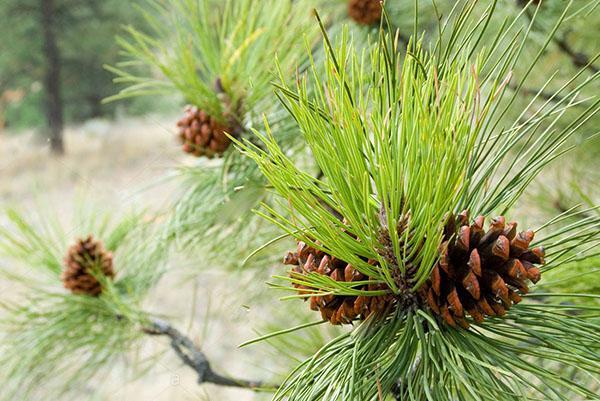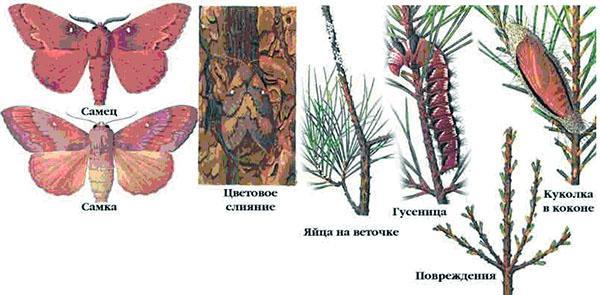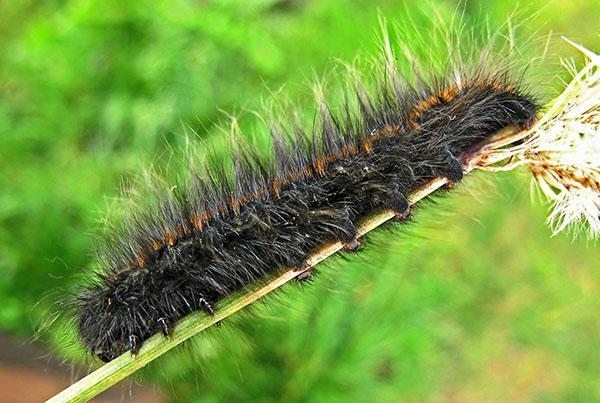Pine pests and methods of dealing with them
 Pine pests are insects that damage parts of plants or even cause their death in the course of their life. Various varieties of conifers are widely used for decorative purposes, so they can be seen in parks, recreation areas, in personal plots. Despite the fact that wild pines look strong and resistant, they require care at home, and mandatory preventive treatments for pests must be included in the list of measures. Large insects are better visible on the bark, therefore flukes are considered more dangerous - small caterpillars-pests of conifers.
Pine pests are insects that damage parts of plants or even cause their death in the course of their life. Various varieties of conifers are widely used for decorative purposes, so they can be seen in parks, recreation areas, in personal plots. Despite the fact that wild pines look strong and resistant, they require care at home, and mandatory preventive treatments for pests must be included in the list of measures. Large insects are better visible on the bark, therefore flukes are considered more dangerous - small caterpillars-pests of conifers.
Needle pests

Pine silkworm
 This pest often appears on the Crimean and mountain pine varieties. In its dangerous phase of development, it looks like a gray-red caterpillar (the color of pine bark), and the largest representatives can grow up to 9 cm.
This pest often appears on the Crimean and mountain pine varieties. In its dangerous phase of development, it looks like a gray-red caterpillar (the color of pine bark), and the largest representatives can grow up to 9 cm.
One pest can destroy up to 700 needles per season, so it is better to deal with it immediately after it appears.
The development of the pine silkworm takes place in several stages:
- in July, large butterflies appear with wings the color of tree bark, span up to 7-9 cm;
- butterflies lay eggs on bark and needles;
- in 2-3 weeks caterpillars emerge - pests of needles;
- in late summer, caterpillars form cocoons on trees.
Pine moth control measures include the use of insecticides based on chitin synthesis inhibitors (Decis, Aktara and others).
Pine sawflies
 This group of pests includes several types of insects that feed on pine needles. Less dangerous are those that use last year's leaves. Other species harm the needles of the current year, significantly affect the vegetation processes and can lead to the death of the pine.
This group of pests includes several types of insects that feed on pine needles. Less dangerous are those that use last year's leaves. Other species harm the needles of the current year, significantly affect the vegetation processes and can lead to the death of the pine.
Sawflies also develop in several stages and differ visually:
- The reddish pine sawfly is more common on Scotch, Mountain and Crimean pines. Butterflies of this species reach 7-8 mm in length and differ in sex: the female is red with a yellow tint on the wings, the male is black. The caterpillar (caterpillar) is gray with a green tint, with a light stripe along the body and a dark head. The older larvae eat the needles completely, after the younger ones, dry, deformed leaves remain.

- The common pine sawfly is one of the most dangerous representatives, since it feeds, among other things, on young needles. Males of butterflies are black with yellow limbs, the color of females may differ. Females lay up to 150 eggs from which caterpillars develop.

- The red-headed weaver sawfly is one of the pine pests that prefers common and weymouth tree species. Butterflies of this insect are blue, with a black or red head.

When black caterpillars appear on the pine, it is worth immediately treating the trees with insecticides (Decis, Karate, Bliskovka and their analogues). Large individuals can be collected and destroyed by hand. On sale there are both specialized remedies from the pine sawfly, and complex preparations.
Other pests of pine
 Most pine needles pests Are caterpillars. They appear in summer, after the butterfly period, and persist until pupation. If you do not get rid of them, then the life cycle of these insects is repeated, which significantly harms the trees.
Most pine needles pests Are caterpillars. They appear in summer, after the butterfly period, and persist until pupation. If you do not get rid of them, then the life cycle of these insects is repeated, which significantly harms the trees.
The most common pine needles-eating pests include:
- pine hawk - a caterpillar with a greenish tint and darkening on the back, rarely appears in large numbers;

- pine scoop - bright green larva with 5 white markings and a contrasting yellow longitudinal stripe;

- the pine moth is a gray-green caterpillar with 5 white stripes on its back.

Control measures against pine moth, scoop, hawk moth and other pests do not differ. If caterpillars appear on the needles, they can be collected by hand. However, using insecticides is more effective.
Sucking pests
 Sucking pests, despite their small size, are more dangerous for trees, since they feed on their sap. If the changes are not noticed in time and insects are not removed, their reproduction can significantly affect the vegetative processes.
Sucking pests, despite their small size, are more dangerous for trees, since they feed on their sap. If the changes are not noticed in time and insects are not removed, their reproduction can significantly affect the vegetative processes.
There are several types of sucking pests that affect conifers in temperate climates:
- The pine birch bug is a small gray-brown insect with a pear scent. When it appears, yellow-brown spots appear on the bark, and then resin smudges. At the same time, the quality of the needles is deteriorating.

- Pine brown aphid - its representatives can be wingless or winged, have a dark, rounded body. At first, they settle on young shoots, and then gradually move to older sites.

- Pine fusiform scale is a common pest. Larvae and adults feed on tree sap, while the needles gradually become brown and fall off.

- Red pine gall midge is an insect that can reach up to 3 mm in length. Its larva is colorless at first, and then takes on a red-orange tint.

The only way to control sucking pests is by using commercial insecticides. Due to the small size of the insects and their location in the bark of trees, it is impossible to remove them manually.
Insects affecting needles, shoots and roots
 This group includes a large number of insects. They feed on bark, roots, needles, young and last year's shoots. If these pests appear in large numbers, they can even cause the death of the plant. Many of this group of pests - beetles.
This group includes a large number of insects. They feed on bark, roots, needles, young and last year's shoots. If these pests appear in large numbers, they can even cause the death of the plant. Many of this group of pests - beetles.
The most common among them:
- gray-haired pine weevil - adult beetles (up to 11 mm in length) feed on bark and needles, larvae damage the roots;

- point resin - small beetles (up to 7 mm) are dangerous for bark and needles, and the larvae gnaw through the passages in the tree;

- large pine weevil - prefers young trees.

Some pine pests are butterflies of the Shootweed family. This group includes summer shoots, resinous, budding and wintering ones. For trees, the larvae of these insects are dangerous, which may differ: in wintering victorious it is a black caterpillar, in others it can be brown, gray, orange.
When choosing how to spray pine from caterpillars, you should pay attention to the composition of the drug and instructions for use. For prophylactic treatments, it is better to use complex products that contain active ingredients against many insects at the same time.
Pine pests are insects that damage the bark, shoots, needles or roots of trees in the course of their life. They can belong to different groups, but most often the larval stages bring harm. The fight against caterpillars should be annual. It is enough to use insecticides according to the instructions, and pests will not appear on the site.